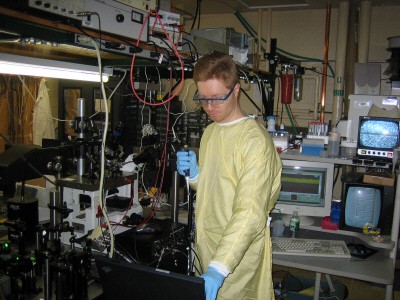Optical physicists in the US have invented a way of detecting single nanoparticles in real time. Devised by Filipp Ignatovich and Lukas Novotny of the University of Rochester in New York, the new technique involves measuring the amplitude of light scattered from the particles and can detect objects as small as 5 nanometres in diameter. The researchers say the method could be used to detect viruses or to build sensors that provide early warning of biological weapons (Phys. Rev. Lett. 96 013901).

Until now it has only been possible to detect single nanoparticles with indirect techniques, such as labelling them with a fluorescent molecule or by immobilising the particles on a surface and then analysing them. Real-time detection is therefore impossible with these methods. Moreover, conventional optical techniques for detecting micron-sized particles, which involve measuring the intensity of light scattered from them, do not work for nano-metre sized particles. The new technique developed by Ignatovich and Novotny has now overcome these problems.
The Rochester researchers first illuminate single particles with a focused laser beam. Next, they collect the light scattered by a particle using the focusing objective of a lens and combine this light with a reference laser beam on the surface of a “quadrant detector”. The scattered light and the reference light create an interferometric pattern that the two physicists then measure — using a device known as a split detector — to extract the scattered light’s amplitude. This amplitude is subsequently used to calculate the size of the particle.
The advantage of the technique is that it measures the amplitude — rather than the intensity — of the scattered light. The amplitude only decreases with the cube of the particle size, whereas the intensity of the scattered light decreases six-fold with particle size. This is why conventional optical techniques, which involve measuing the intensity of the scattered light, cannot detect nanoscale particles.
Another advantage of the technique is that there is no signal in the absence of a particle thanks to the split detector, which means the measurement is free from background noise. Ignatovich and Novotny have already used their technique to measure gold particles as small as 5 nanometres across in just milliseconds. The duo has also shown that the method can detect influenza virions — the term used for viruses before they enter a host cell — and distinguish them from polystyrene beads.
“We are now working on detecting viruses, which are usually too small to be detected by other methods individually and in real time,” says Ignatovich. “By improving the sensitivity of our method further we even hope to distinguish different virus strains.” The physicists are working closely with David Topham, also at the University of Rochester, and Tuli Mukhopadhyay at Indiana University for this work.
The team says its technique could be used to detect pathogens and in sensors that provide early warning of biological threats. It could also be used to monitor nanoparticle contamination when fabricating silicon chips.




